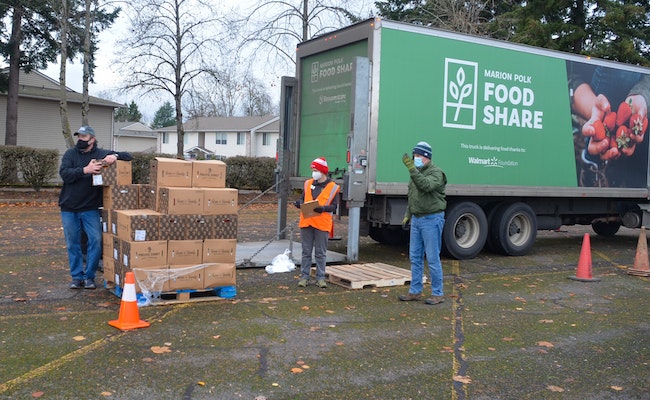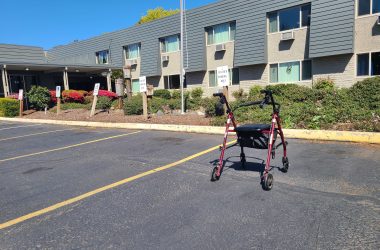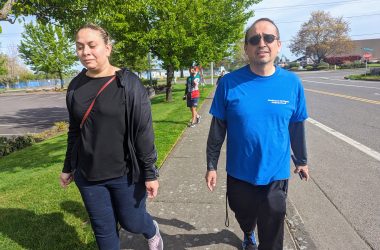 John Hawkins, right, waves a car forward as Mitch Baysinger, left, and Rachel Peterson unload a pallet of food boxes at Chemeketa Community College for a food giveaway on Nov. 24 (Rachel Alexander/Salem Reporter)
John Hawkins, right, waves a car forward as Mitch Baysinger, left, and Rachel Peterson unload a pallet of food boxes at Chemeketa Community College for a food giveaway on Nov. 24 (Rachel Alexander/Salem Reporter)
When Rachel Peterson arrived at the Chemeketa Community College parking lot, she found a line of cars already waiting.
It was the Tuesday before Thanksgiving, and Marion Polk Food Share was scheduled to begin handing out boxes of food at 4 p.m.
Peterson and two other workers parked a truck loaded with food and began unloading it nearly an hour early, placing boxes with frozen chicken, oranges, yogurt and other staples into cars driving through.
They handed out 100 boxes of food before the event had been scheduled to start.
“It seems like every week they start lining up earlier,” Peterson said.
The food share, which supplies about 44 food banks and pantries in the greater Salem area, is now serving about 13,000 unique families at pantries each month, CEO Rick Gaupo said. That’s up from about 10,000 before the pandemic began.
They’re also passing out hundreds of boxes directly to families at weekly events in Gervais, Monmouth and Salem, part of a federal pandemic relief program to buy surplus food from farmers that would have gone to restaurants or schools and give it to families in need.
Those giveaways will run to the end of the year and are open to anyone – no paperwork or identification needed.
Some have the entire family in the car, while others are alone. Some ask about other resources, or wish the workers a happy Thanksgiving. Others just say thank you before driving off.
Those who do say why they’re there often point to a recent job loss or other impacts of the pandemic, Peterson said.
Gaupo said food banks typically see spikes in need when unemployment rises.
When unemployment is low, he said, pantries mostly serve working people who don’t earn enough to cover necessities. Housing and health care tend to eat up family budgets, he said, and it’s often easier to find help with food than rent.
“For the most parts, food banks are serving people who are employed and are working hard and struggling to meet the pressures of our economy,” Gaupo said. “That gets exasperated when unemployment increases.”
 People seeking help with food in the Salem area is up significantly over 2019, according to data from Marion Polk Food Share. “Individuals impacted” counts all people in a household each time they visit a food pantry. (Courtesy/Marion Polk Food Share)
People seeking help with food in the Salem area is up significantly over 2019, according to data from Marion Polk Food Share. “Individuals impacted” counts all people in a household each time they visit a food pantry. (Courtesy/Marion Polk Food Share)
The food share saw a spike in demand in the spring as many workers lost jobs. That continued through July, he said, then dipped a bit in August following some businesses reopening and bringing back employees.
Wildfire evacuations greatly increased the need for food help, Gaupo said, but so many churches, community groups and volunteer efforts stepped up to feed people in the Santiam Canyon that their efforts met the demand.
Meals on Wheels, which delivers ready-made meals to homebound seniors, has also seen a rise because of the number of vulnerable people staying home during the pandemic. The number of daily meals going out has increased from about 500 to 700
Gaupo said the food share has been able to meet rising demand thanks to community donations, but the pandemic and the surge in need has changed many of their day-to-day operations.
Before the pandemic, food pantry workers typically came to the food share warehouse to pick up needed items. Now, the food share is doing more deliveries to minimize the number of people coming in and out of the facility.
That’s meant a need to buy more vans and trucks, and increase refrigerated storage at their main warehouse in northeast Salem.
Gaupo said those purchases also helped move food to needed spots following the wildfires and will give the food share more flexibility even after the pandemic. They’ve also hired more workers for the warehouse to help distribute food.
“The recovery will be long-term and we want to invest into more programs that are going to have long-term impacts in the communities,” he said.
 A USDA food box distributed on Nov. 24 contained dairy, meat and fresh produce (Rachel Alexander/Salem Reporter)
A USDA food box distributed on Nov. 24 contained dairy, meat and fresh produce (Rachel Alexander/Salem Reporter)
Weekly food box distributions like the one at Chemeketa are scheduled to run through the end of the year, when the U.S. Department of Agriculture funding for the program runs out. Last week’s event went through nearly 500 boxes, requiring a second truck to come less than an hour into the event.
People can always get food at a local pantry, Gaupo said. A list is available on the food share website. Pantries have income guidelines, but run on an honor system and don’t require proof of income or identification to get help.
Gaupo said few people would opt to stand in line to get a box of food they may not be able to choose if they had the means to go to the grocery store at a convenient time and buy whatever they wanted.
“If you say you qualify we believe you qualify,” he said. “What I care about is that no one is hungry in our community.”
Contact reporter Rachel Alexander: [email protected] or 503-575-1241.
HOLIDAY SPECIAL: SAVE 25% off a one-year subscription to Salem Reporter. Get quality Salem news delivered to your inbox. Every subscription helps build coverage of the Salem community. Order online HERE.

Rachel Alexander is Salem Reporter’s managing editor. She joined Salem Reporter when it was founded in 2018 and covers city news, education, nonprofits and a little bit of everything else. She’s been a journalist in Oregon and Washington for a decade. Outside of work, she’s a skater and board member with Salem’s Cherry City Roller Derby and can often be found with her nose buried in a book.









